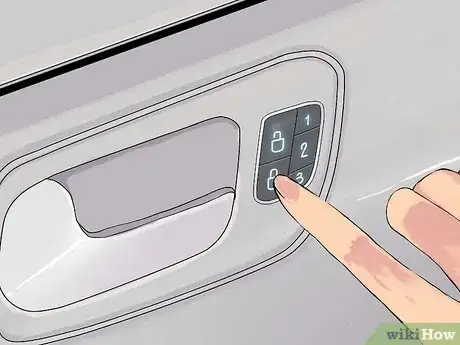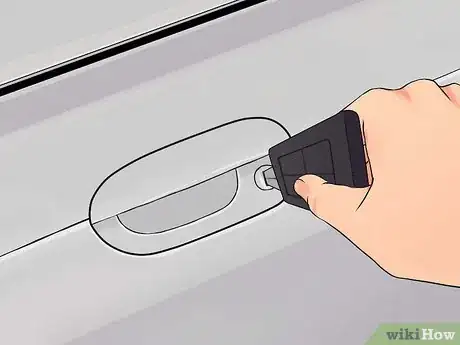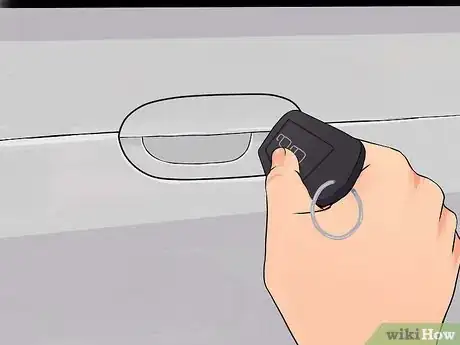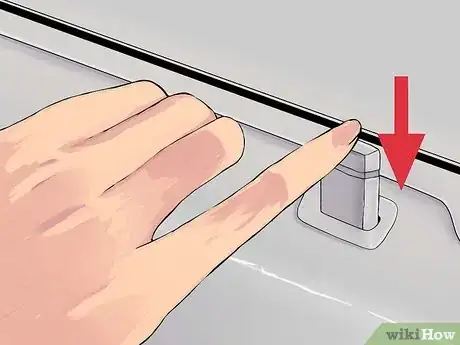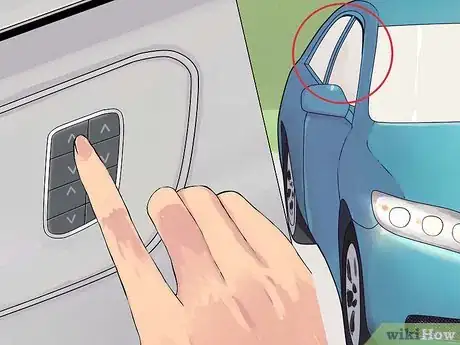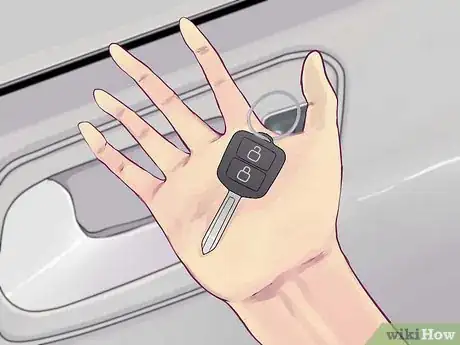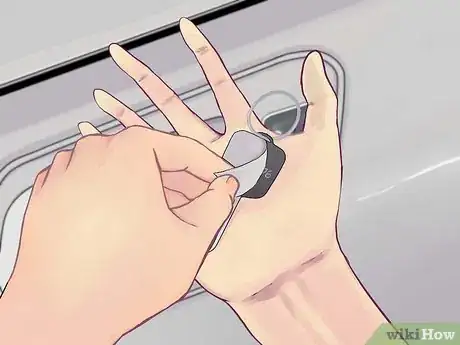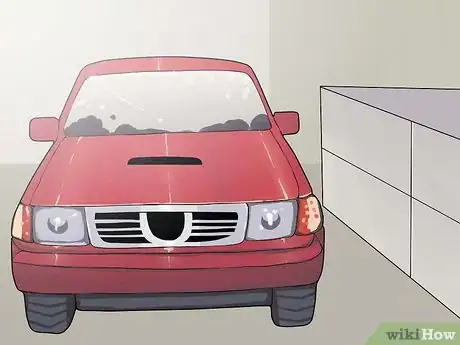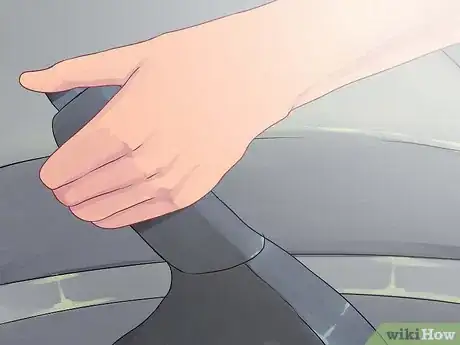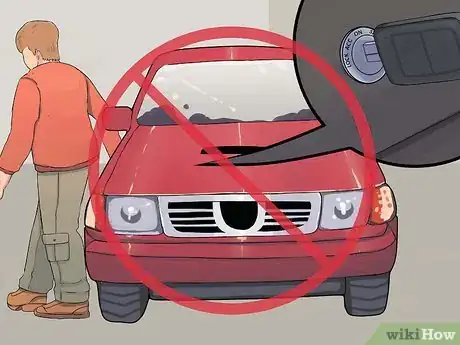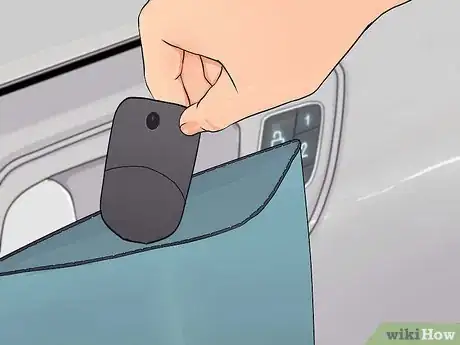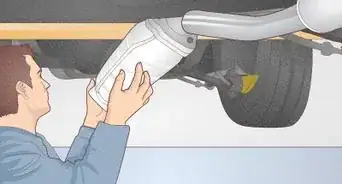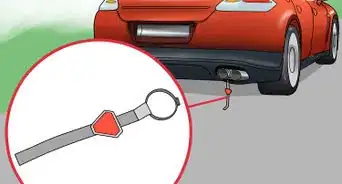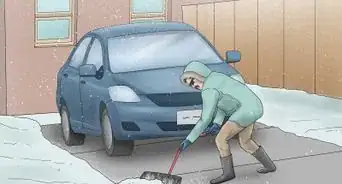X
wikiHow is a “wiki,” similar to Wikipedia, which means that many of our articles are co-written by multiple authors. To create this article, volunteer authors worked to edit and improve it over time.
There are 8 references cited in this article, which can be found at the bottom of the page.
This article has been viewed 107,267 times.
Learn more...
Most cars can be locked both manually and automatically, but regardless of how you do it, locking your car is one of the simplest and most important actions you can take to prevent theft and improve safety. You should always lock your car after leaving the vehicle and while you're actually inside it.
Steps
Method 1
Method 1 of 3:
Part One: Standard Ways to Lock the Car
-
1Check the operator's manual. All cars have manual methods of locking and unlocking the doors, but nowadays, the vast majority also have automatic locks. Check the vehicle's instruction manual to determine which locking mechanisms your car has.
- If you do not have the operator's manual, check inside the car to look for automatic lock buttons. Cars that do not have internal automatic locks probably don't have external automatic locks, either.
- You can also check the car key to determine whether or not the car has automatic locks. Vehicles equipped with such locks usually have keys with lock buttons on them, but if your car key does not have any buttons on it, you probably won't be able to lock and unlock the car automatically from the outside.
-
2Lock the car manually from the inside. When you get into the car, you can usually lock all of the doors manually.
- Manual locks can be located at the base of the window frame or on the side of the door, near the handle. Switching the lock to the "down" position usually locks it, while flipping it "up" typically unlocks it.
- When using manual locks, you will likely need to lock all doors separately.
Advertisement -
3Internally activate the automatic locks. Cars equipped with automatic locks have an automatic lock button near the handle of the door and/or in the center console.
- These buttons are typically labeled with the image of a traditional lock. Pressing the button down toward the closed lock image will lock the car, but pulling the button up toward the open lock image will unlock the car.
- In most cases, pressing the automatic lock button from any point in the car will lock all of the vehicle's doors.
-
4Manually lock the car with the key. As long as the car door has a manual lock on the handle, you should be able to manually lock it from the outside.
- Most cars only have locks on the two front doors (driver side and passenger side). Some may only have a lock on the front driver side door.
- Insert the key into the keyhole and turn it toward the trunk. Doing so should lock the car. Turning it toward the hood should unlock the car.
- Note that in some cars, the car lock might be reversed. If turning toward the trunk does not lock the door, try turning it toward the front of the car.
-
5Use the lock button on the key. To lock automatic locks from the outside, you'll usually need to use the lock button on the key.
- In most cases, the lock button will be clearly identified by a closed lock icon.
- Most keys also have a separate unlock button marked by an open lock icon.
-
6Lock the car with a keyless remote. In some cases, the automatic locks can be operated with a wireless key fob instead of an actual key.
- Key fob remotes are built into keychains. There might be a "lock" icon on the keychain you can use to lock the car, but this isn't always the case.
- Sometimes, you will need to keep the key fob nearby while standing directly next to the vehicle. There should be an unmarked button on the car handle. Press the button once to unlock the vehicle and twice to lock it. This will only work if the key fob is within a certain distance of the vehicle itself, however, and this distance can vary by manufacturer and model.
Advertisement
Method 2
Method 2 of 3:
Part Two: Reasons for Locking the Car
-
1Prevent theft. Locking your car limits access. As a result, potential car thieves will have a harder time breaking into it, making it a less appealing target for theft.[1]
- On average, roughly half of the cars stolen in combined urban, suburban, and rural areas were left unlocked at the time of the theft.
- In addition to locking your car, you should also take extra precautions to discourage potential thieves from targeting your vehicle. Most thieves will opt for an easy target over a hard one, so the less accessible your car is, the less likely it is to be stolen.
-
2Protect yourself. Keeping the car locked while you're inside the vehicle can help prevent kidnappings and carjackings.
- Anyone with a weapon can target you while you're in the car. If a potential threat approaches the car without you noticing, you stand a better chance of noticing in time and driving away unharmed if the criminal is delayed by a locked door.
- You can also protect yourself from kidnappings and carjackings by traveling on well-lit, busy roads, especially when it's dark outside. Be as aware of your surroundings as possible and keep the car in gear at stop signs and traffic lights so that you can drive away from potential threats quicker.
Advertisement
Method 3
Method 3 of 3:
Part Three: Extra Precautions
-
1Keep the windows up. Keep the windows completely rolled up. In many cases, open windows make it possible for thieves to unlock the door.[2]
- You shouldn't even leave the window cracked on a hot day. Depending on the design of the car, it might be possible for a thief to grab onto the lock with a hook or wire and open the car that way.
-
2Take your keys. Regardless of whether you lock the car or not, you should remove all sets of car keys from the vehicle and take them with you.[3]
- Approximately 13 percent of stolen vehicles have keys at them at the time of the crime.
- If you do leave a second set of keys in the car, you should hide them in an unusual and hard-to-reach spot. Professional car thieves know just about all of the possible hiding places, however, so it is still better to remove the keys completely than it is to hide them.
-
3Set the alarm. If your car comes equipped with an alarm, set the alarm every time you leave the vehicle.
- Even if your car is equipped with an alarm from the manufacturer, it can be a good idea to install a secondary alarm, as well. More layers of security are better than fewer. Opt for an alarm that activates sirens, horns, and lights for maximum coverage.
-
4Remove number codes from your key. If potential thieves know your car's key code, they might be able to make a copy of that key without the key itself. Remove visible signs of the key code from your keys to prevent this from happening.
- Some keys have the number stamped directly on the key, in which case, you should cover it with a sticker or something similar. In other cases, the key code will be on a separate sticker, decal, or tag that can be completely removed from the key.[4]
-
5Park your car in secure locations. Park your car in a garage when possible, especially when parking at home. If you need to park your car in an open lot, choose the best possible location for it.[5]
- It is much more difficult for thieves to break into both a garage and a car, so using your home garage is strongly recommended. Make sure that both the garage and car are locked to provide maximum security.
- When parking in an open lot, choose a well-lit area and a crowded lot. Avoid parking in between large vehicles that hide your car, too. More people and improved visibility will both deter potential thieves.
- When possible, you should also park close to your destination for the sake of your own safety.
-
6Make the car difficult to tow. Nowadays, some advanced thieves may attempt to steal your vehicle by towing it away. There are some things you can do to make your car tougher to tow, however.
- Turn the tires toward the curb when parallel parking. When parking in a driveway or parking lot, turn the tires as far to one side as possible.
- Back into your driveway if your car is equipped with rear-wheel drive. The rear wheels will lock, making it harder to tow. Cars that only have front-wheel drive should be parked front-end forward.
- Use the emergency brake when you park your car, as well.
-
7Never leave the car running. Ideally, you should only run the car when you're actually inside it. Never leave your car with the key still in the ignition, even if you only need to leave for a minute or so.[6]
- Plenty of cars are stolen at ATMs, gas stations, and other similar locations when their owners leave the engine running.
- Similarly, some cars are stolen from driveways, streets, and parking lots when their owners leave the vehicle running to warm it up on a cold day.
-
8Keep several forms of identification. At minimum, you should carry the vehicle's registration with you in your purse or wallet instead of keeping it in the car.
- Keeping the registration in your car can make it easier for a thief to sell it, and it also has your home address on it, giving the thief knowledge of where you live. For the same reasons, you should also keep the title filed away in your house.
- You should also know your car's Vehicle Identification Number (VIN), which will make the car easier to identify if it does get stolen. Etch the VIN into all windows and take plenty of pictures of your car with the plate number visible to show police.
- Another way you can make it easier for police to identify your car is to place identification markers, like dye markers and engravings, around multiple places, including tailgates, spoilers, and under the hood.
-
9Hide all valuables. It's best to remove valuables from your car, but if you need to keep something of value in your vehicle temporarily, make sure that it is hidden out of sight.[7]
- While valuables don't make your car easier to break into, they can make the car seem more tempting.
- Do not hide your valuables under a blanket or jacket since this can still seem obvious to many thieves. Don't keep them in your glove compartment or center console, either, since most thieves will think to look there. If you need to leave a valuable in your car, the best place for it is usually the trunk.
- While you may not necessarily think of it as a "valuable," you should also remove your garage door remote since it can provide thieves with access to your home.
Advertisement
Community Q&A
-
QuestionIf I lock my car manually in a car with automatic locking, can I open the car manually?
 Community AnswerYes. There should be a key hole to use your key in. By using the handle from the inside, it always unlocks unless there is child safety lock on.
Community AnswerYes. There should be a key hole to use your key in. By using the handle from the inside, it always unlocks unless there is child safety lock on. -
QuestionI heard you should lock your car from inside instead of using the lock on the key. Is that true?
 Community AnswerIt really makes no difference, as long as you're sure you've locked it. The only time it would make a difference is if there's a problem with either one of your locks or your key (or you happen to press the wrong button).
Community AnswerIt really makes no difference, as long as you're sure you've locked it. The only time it would make a difference is if there's a problem with either one of your locks or your key (or you happen to press the wrong button). -
QuestionCan I lock the car door if my second set of remote keys are in the car?
 MurialvoidCommunity AnswerIt depends on the model, but most modern cars require you to not have keys inside the car in order to lock it.
MurialvoidCommunity AnswerIt depends on the model, but most modern cars require you to not have keys inside the car in order to lock it.
Advertisement
References
- ↑ https://www.nhtsa.gov/road-safety/vehicle-theft-prevention
- ↑ http://www.cityofhomer-ak.gov/police/prevent-theft-lock-your-vehicle
- ↑ https://www.allstate.com/blog/10-tips-to-avoid-car-theft/
- ↑ http://www.triple-c.com/How_to_find_your_cars_lock_or_key_code.cfm
- ↑ https://www.nhtsa.gov/road-safety/vehicle-theft-prevention
- ↑ https://www.safewise.com/blog/7-ways-avoid-getting-car-stolen/
- ↑ https://www.geico.com/information/safety/auto/preventing-auto-theft/
- https://cars.usnews.com/cars-trucks/how-to-prevent-car-theft
About This Article
Advertisement


